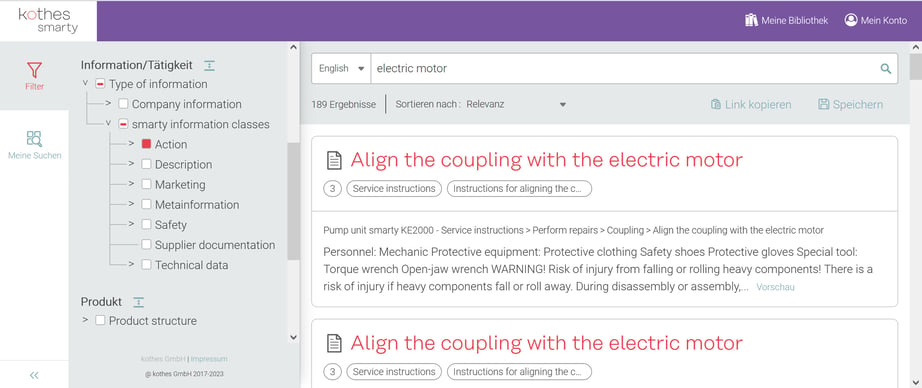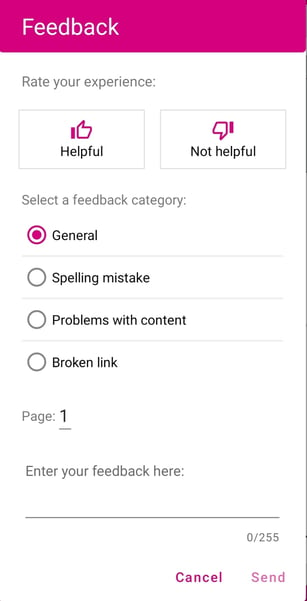Practical search function, updatability, lower printing costs:
Digital user information has many advantages – both for manufacturers and for users. But digital is not just digital.
We'll show you how best to make the transformation to paperless documentation.
First step: PDF
For many companies, the traditional PDF document is the first step toward publishing information digitally. In most cases, the PDF file is made available to users via download on the Web or on a data carrier (e.g. USB Stick) that is included with the product.
We could almost put a check mark next to the "digital" requirement. But only almost, because it becomes clear in the practical test at the latest that with a simple PDF file, we're still miles away from what digitisation actually means – simple and contextual access to really relevant information.
This is primarily because PDFs are still optimised for printing.
I recently experienced an extreme example of this with a fairly simple electrical appliance. The manufacturer offered a DIN-A0 PDF as instructions, consisting of a few graphics and text in 26 languages. A text-picture-assignment was only possible by lengthy back-and-forth scrolling, which made the understanding very difficult. Printing is of course not a realistic option for the end user with such a document format.
Rigid documents, tedious searching
But even conventional PDF instructions in A4 format don't perform particularly well when you need specific information. For example, the search function in a PDF simply lists all the places where a term is found without sorting them by relevance – this is much better with a traditional search engine such as Google. In addition, the rigid page format can significantly interfere with the absorption and digestion of information, for example when a page break separates the helpful image from the associated text. Especially when reading on a smartphone, this is no longer just annoying, but also frustrating.
Other reasons that speak against the PDF: Something like the targeted sharing of content, for example, to inform another team member, doesn't usually work with a PDF. Also, once documents are delivered, they're often not updated further in case of errors, just like the printed version.
Interim conclusion: PDF is digital, but in many aspects it's not yet a real advance on the traditional printed manual.
Second step: Using a Content Delivery Portal to get out of the PDF mess
When it comes to the digital future of technical documentation, there is increasing talk of so-called Content Delivery Portals (CDPs). What exactly is this all about?
The main idea of a CDP is to create a central information platform that provides users with exactly the information they need in a particular situation. For this purpose, the sometimes huge instruction documents are first divided into small, easily digestible information bites – the Topics. A Topic describes exactly one thing or explains how exactly a task can be performed. The topic is then tagged with metadata that helps make it easier to find. These Topics are then made available via a portal. Users can then search for the information they're looking for in a simple Google-like manner. The hits are sorted by relevance (also like Google), even if the user doesn't know the appropriate term and is looking for a synonym.
Find the information you're looking for faster
But that's by no means all. To further narrow down the search results, a function familiar from the world of online stores is used: the Facets.
These are the tree structures that can be found, for example, in the Amazon search on the left edge of the screen. They visualise the different characteristics and features of the products and quickly help me, as a layman, to narrow down my search to exactly what I want.
Exactly such a function is also available in most Content Delivery Portals. However, it's not used to select products, but to filter the information offered within the portal. For example, if I want to know the optimum tyre pressure for my car, I simply enter "tyre pressure" in the portal search. Then, with just two clicks, I can specify which model I'm driving and that I'm looking for information on the front tyres.

Quick access to information: Facets in the CDP (source: kothes smart space)
The focus is on the user
But smart content delivery can do much more: The systems usually offer functions that allow users to save favourites and bookmarks, compile their own collections of topics, and share content with colleagues.
In addition, some of the currently available portals are already equipped with an interactive feedback function. This can be used intuitively and is reminiscent of the rating function in e-commerce. Individual topics can be rated by using a star system. Free text comments also serve as a kind of notepad for recording detailed feedback and feeding it back into the organisation. These can be comments such as:
Torque information is still missing here. Or: Please adjust setpoint parameters to the current release.
This enables those responsible for information to see at a glance where important information is still missing in the portal and to update it. Incorrect or outdated information can also be identified and improved more quickly.

Where is information still missing? The feedback window in a CDP (Source: Empolis Service Express)
Last but not least, there are systems that have an app for the user: This allows users to access the portal on the move via smartphone – even offline. A rights system for protecting sensitive information and the ability to update content at any time round out the whole thing.
More than just instructions – the CDP as a central information and knowledge management portal
When we consider the versatile features of CDPs, we can see:
These systems provide everything to build a powerful information and knowledge platform. Such a platform can offer much more than just the small basics of technical documentation. It can also provide more detailed information for a wide range of target audiences via the CDP. This could be, for example, troubleshooting for the Service department, FAQs for the Hotline, or information on accessories and expansion options for end customers.
The potential of CDPs has been recognised in the Technical Service sector in particular. Information portals that are specially tailored to the needs of Service organisations are currently becoming increasingly established in this area.
Such portals offer, for example, the option of creating guided troubleshooting on the basis of intelligent decision trees. This helps to better isolate problems and can reduce the training time of new employees by up to 75%.
Why is printed documentation still so prevalent?
If you compare the practical benefit of information in paper form or in PDF format with information in the Content Delivery Portal, the CDP usually wins. But more often than not, the user information we use in our personal lives or even in business is still printed or delivered as a PDF. Why is that?
Reason 1: The investment cost
First of all, it's of course an investment for manufacturers to set up such a portal and prepare the content accordingly. The larger manufacturers, for example in the Automotive sector, are pioneers here and are already using CDPs. Medium-sized and small companies will sooner or later follow suit, because the advantages are obvious.
What's more, Gen Z consumers, at the latest, will prefer products for which they can obtain information digitally. It will therefore become increasingly important for manufacturers to create current and easily accessible content that's tailored precisely to the information needs of users.
Reason 2: Only paper is considered secure
The second point lies in the current legislation and its interpretation. Many experts are still propagating the idea that the printed version is the only "legally valid" form of delivery for Operating Manuals. This is because printed paper is the only way to ensure that the information is available at all times (even in the event of a power outage or dropping of the Internet connection). But this line is crumbling. For example, manufacturers of medical devices have long been allowed to dispense with paper under certain circumstances. The current draft of the new Machinery Directive also explicitly permits digital delivery of Operating Manuals for machines. However, there's one small restriction: at the customer's request, a paper version must be supplied within six months of purchase.
Nevertheless, it can be said that the legislator has also recognised the signs of the digital transformation and is finally formulating concrete regulations for technical documentation in digital form (see Draft Machinery Directive).
Conclusion: Information at any time and any place – content delivery makes it possible
"A document with over 500 pages, and on page 243 you find the info." Sentences like this could already be a thing of the past today – with smart content delivery.
In any case, I'm already looking forward to the time when manufacturers gain market share because they inform their users better than the competition with digital information. Not only because one or the other tree will end up giving its life to be made into a manual, but also because we as users will then have to spend much less time searching for the right information.


